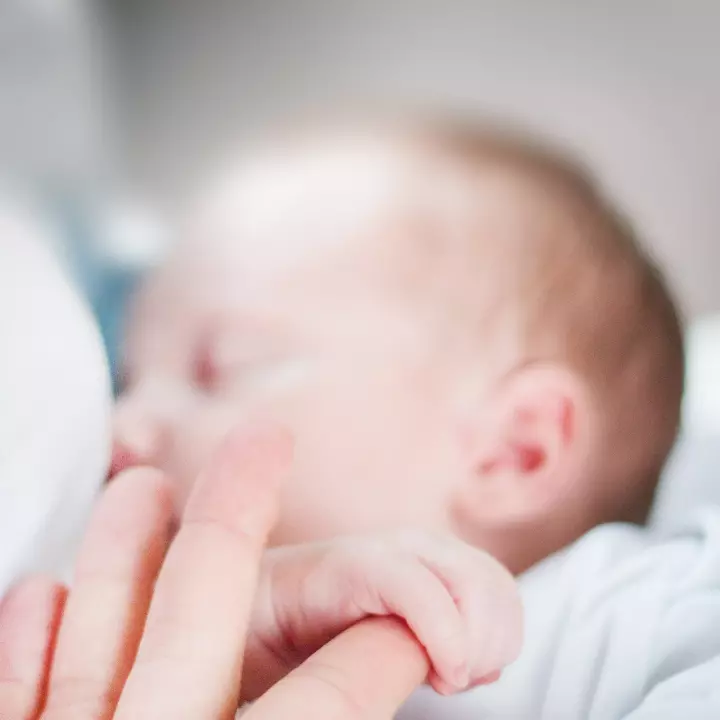7 Common (but often unexpected) things babies can be born with
Bella Brennan
Bella Brennan
Welcoming your baby into the world is perhaps the most joyful yet overwhelming time of your life. After nine months of growing this mysterious person, you finally get to meet them for the very first time! Locking eyes with your newborn is a moment like no other.
But sometimes new parents may have to face things they didn’t quite prepare for. Sure, you may have read all the books on pregnancy and sleep but the miracle of birth accounts for so many unforeseen circumstances.
Whether it’s an extra finger, a birthmark or dealing with jaundice – here are 7 common (but often unexpected) things babies can be born with.
1. Extra digits
Babies can be born with an extra finger or toe – which is medically called polydactyly. It is usually only present on one hand or foot but can sometimes affect both. Polydactyly most commonly appears on the pinky finger side of the hand or the pinky toe side of the foot. The extra finger or toe causes no harm to the baby but can sometimes be part of a larger genetic syndrome. Depending on the location of the finger or toe, surgery can be performed to remove it.
Sign up
Get tailored content based on your week of pregnancy
By signing up, you agree to receiving our Newsletters. Cancel anytime.



2. Stork bite
Stork bites (also known as angel kisses or salmon patches) can be found on the nape of bub’s neck or on their eyelids. The speckled light red colouring, which is technically called nevus simplex, is completely harmless and is just a collection of capillary blood vessels that have been stretched and will usually fade over time.
3. Forcep marks
Depending on how your baby entered the world, they may have needed a little extra help getting out. While forceps are a safe way to help deliver a baby, they can leave behind red marks on your baby’s head (chignon) or face, which usually disappear within 48 hours. Bruises and cuts are also common from assisted deliveries.
4. Misshapen head from vacuum
Don’t stress if your baby’s head looks a little misshapen in the first few days after birth – it’s totally normal! If your baby was delivered with the help of a vacuum, their head can often change shape and swell from the suction. It should settle down in a few days.
5. Strawberry marks and other birthmarks
Raised red or purple birthmarks (haemangiomas or strawberry naevus) are caused by an overgrowth of cells inside blood vessels. It may be present at birth or develop afterwards. When they first appear, they grow quite quickly but usually shrink or completely disappear by the time the child is ten.
Pigmented birthmarks are also common in children and can present as coffee-coloured patches or blue-grey spots anywhere on the body.
6. Jaundice
Noticed that your little one has come out with a yellowish tinge to their skin and wondering how on earth they’ve already managed to get a better tan than you? Jaundice in newborns is a common condition and causes bub’s skin and the whites of their eyes to go yellow. Jaundice babies can also be drowsy and struggle to feed.
So, what causes it exactly? Jaundice happens when there’s too much waste product known as bilirubin in the baby’s blood. Following birth, the midwives will monitor your baby’s jaundice levels with a special thermometer called a bilirubinometer. They can also perform a heel prick test and draw blood for a more accurate reading.
For more severe cases of jaundice, babies can be treated with phototherapy treatment, which uses a special blue light to break down the bilirubin. Babies are put naked in a cot under the blue light for around two to three days.
7. Extra hair everywhere
Fresh outta the womb and rocking a dusting of head-to-toe hair? Again, don’t panic! Babies can be born with a soft peach-like fuzz all over their bodies. It’s actually called lanugo and is a normal part of a baby’s development in utero to keep them all warm and snug. Often the hair is shed into the amniotic fluids around the 32-36 week mark of pregnancy but sometimes, it hangs around until birth. However, it usually vanishes after the newborn stage. Think of them as your extra cuddly little koala!
Remember it’s totally normal for babies to be born with all of these things! It doesn’t make your little one any less special or loved. But if you are worried about any of these issues, speak to your GP or paediatrician.
Related Articles
Causes of jaundice in babies and how is it treated?
Understanding your baby’s sleep and awake times
6 things you need to know about reading the signs… (in the first year)
Related Articles
Bella Brennan
Follow +Bella is a writer and editor with over a decade of experience in women’s publishing and digital media. In her spare time, she loves making up dances to the Wiggles with her two little girls, swimming in the ocean and trying to sneak away from her family for a cheeky nap.











